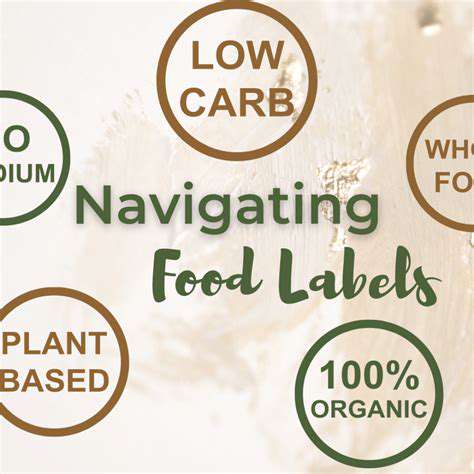Guide to Understanding Food Additives and Their Impact
What Are Food Additives, Exactly?
What are Food Additives?
Food additives are substances added to food to improve its appearance, texture, taste, or shelf life. They are used for a variety of reasons, from preventing spoilage and extending the time food remains fresh and safe to eat to enhancing the visual appeal of food products and making them more palatable. Many additives are natural substances, but some are synthetically produced. It's important to understand that the presence of additives in food is not inherently harmful; many additives are crucial in maintaining food safety and quality.
The use of food additives is a complex issue. While they can provide benefits for the food industry and consumers, there are also potential concerns about their impact on health. The safety of each additive is carefully evaluated before it's permitted for use in food products. Regulations vary by country, and different jurisdictions have different standards for approving and controlling the use of these additives.
Types of Food Additives
Food additives are categorized into various classes, each with specific functions. Preservatives, for example, prevent the growth of microorganisms, thus extending the shelf life of food products. Antioxidants delay or prevent the deterioration of food through oxidation. Stabilizers maintain the desired consistency of food products, while thickeners increase the viscosity of foods. Colorants enhance the appearance of food products, and flavor enhancers improve the taste of food. Each additive plays a specific role in the food production process, contributing to the final product's characteristics.
Different types of additives serve different purposes. Some additives are used to enhance the flavor profile of food, while others improve the texture or appearance. Understanding the various types of additives and their specific functions is crucial for making informed decisions about the food we consume. The specific types of additives used in a food product are often listed on the label.
Safety and Regulation of Food Additives
The safety of food additives is a critical concern. Before an additive can be used in food products, it undergoes rigorous testing and evaluation by regulatory bodies to ensure its safety for human consumption. These evaluations consider potential health risks, including allergic reactions, long-term effects, and interactions with other substances. The results of these studies are carefully scrutinized to determine if the additive poses any significant risks.
Regulations surrounding food additives vary across countries. Different jurisdictions have established guidelines and standards for the use of additives, focusing on consumer safety and food quality. These regulations often specify the maximum permissible levels of additives in food and the conditions under which they can be used. Understanding these regulations and adhering to them is essential for responsible food production and consumption.
Potential Health Concerns
While food additives are generally considered safe, some individuals may experience adverse reactions to certain additives. These reactions can range from mild discomfort to more serious allergic responses. For example, some individuals may be sensitive to sulfites, a common preservative in many foods. It's crucial for individuals with known allergies or sensitivities to be mindful of the ingredients in the food they consume.
Long-term exposure to certain additives has also been a subject of ongoing research. While studies often show no significant health risks, some studies have raised concerns about potential links between certain additives and long-term health issues. More research is needed to fully understand the potential implications of long-term additive consumption. Consumers should be aware of this ongoing research and make informed choices about their diet.
The Role of Additives in Food Production
Food additives play a vital role in the modern food production process. They contribute to the efficiency and cost-effectiveness of food production, allowing for the mass production of safe and appealing food products. Additives help extend shelf life, maintain quality, and improve the overall consumer experience. Without these additives, many foods we consume daily would have a shorter shelf life, be less appealing, or pose greater safety risks.
Additives contribute significantly to the efficiency of food production by ensuring the quality and shelf life of products. This contributes to the availability of food for consumers, and the cost of production often depends on the use of additives. Understanding the role of additives in food production is crucial for making informed decisions about the food we consume.
The Impact of Food Additives on Health and Well-being

The Role of Food Additives in Modern Food Production
Food additives play a crucial role in modern food production, impacting everything from the safety and shelf life of products to their taste and appearance. These substances, deliberately included in food, are essential for ensuring food quality, safety, and appealing characteristics. Understanding the role of these additives is key to comprehending the complexities of the modern food system.
From preserving food against spoilage to enhancing its texture and color, additives contribute to the wide variety of food products available. Their use is often necessary to overcome challenges associated with food preservation and transportation in today's globally interconnected food market. This ensures that food reaches consumers in good condition and with desirable attributes.
Potential Health Impacts of Food Additives
While food additives are essential for modern food production, concerns remain regarding their potential health impacts. Some additives have been linked to adverse reactions in certain individuals, such as allergies or sensitivities. It is important to acknowledge the potential risks associated with these substances, and ongoing research continues to shed light on these connections.
Moreover, the long-term effects of consuming certain additives over extended periods are still under investigation. While many additives are considered safe by regulatory bodies, further research is always needed to fully understand the complex interplay between additives and human health. The potential for long-term effects necessitates careful consideration and vigilance.
Regulation and Safety Standards for Food Additives
The safety of food additives is a crucial concern, and stringent regulations are in place to govern their use. These regulations are designed to protect consumers from potential harm and ensure that additives are used responsibly. Regulatory bodies worldwide assess the potential risks and benefits of each additive before allowing its use in food products.
The approval process typically involves extensive testing and evaluation to determine the safety and efficacy of the additive in question. Independent scientific assessments, public consultations, and rigorous safety evaluations are crucial components of this process. These processes help to ensure that the food supply remains safe and reliable for consumers.
Alternatives and Minimizing Additive Use
In recent years, there has been a growing interest in minimizing the use of food additives, with many consumers seeking out products with fewer artificial ingredients. Awareness of potential health impacts is prompting consumers to make informed choices when selecting food items. This trend emphasizes the importance of transparency in food labeling and ingredient lists.
Alternatives to synthetic additives are being developed and explored, including natural preservatives and flavor enhancers. These alternatives offer potential benefits in terms of health and safety, although their effectiveness and cost-efficiency may vary. Further research and development in this area are crucial to satisfy consumer demand for healthier and more natural food options.
Navigating Food Labels and Understanding Additive Lists

Understanding Nutrition Facts Panels
Food labels are crucial for making informed dietary choices. Understanding the nutrition facts panel allows you to assess the nutritional content of a food product and determine if it aligns with your dietary needs and goals. This panel provides vital information on calories, nutrients, and serving sizes. A thorough understanding of these labels empowers you to make healthier food choices.
The information typically includes details like serving size, calories per serving, and the amount of fat, saturated fat, cholesterol, sodium, carbohydrates, fiber, sugar, and protein per serving. Knowing these details helps you compare different products and select options that fit your dietary restrictions or preferences.
Deciphering Serving Sizes
Serving sizes are often underestimated or overlooked, leading to inaccurate estimations of calorie and nutrient intake. Pay close attention to the serving size listed on the label, as it's the basis for all the nutritional information provided. Many products contain multiple servings, so be mindful of how much you're actually consuming.
Understanding the serving size is critical for accurate calorie tracking. A single serving might seem small, but if you consume multiple servings throughout the day, the calorie and nutrient intake can quickly accumulate.
Analyzing Macronutrients
Macronutrients, including carbohydrates, proteins, and fats, are essential for bodily functions, but their amounts vary significantly between food items. Understanding the proportion of each macronutrient in a food product is essential for maintaining a balanced diet.
Carbohydrates provide energy, proteins support growth and repair, and fats contribute to hormone production. By evaluating the amount of each macronutrient, you can determine if a food aligns with your dietary needs and preferences.
Evaluating Micronutrients
Micronutrients, such as vitamins and minerals, are essential for various bodily functions. Food labels often list the percentage of the daily value (DV) for each micronutrient. This information helps determine if a food is a good source of specific vitamins and minerals.
Interpreting Daily Values
Daily values (DVs) are reference values for the daily intake of nutrients. They're useful for comparing the nutrient content of different foods, but they don't necessarily reflect individual needs. Understanding DVs allows you to gauge the nutrient density of a food in relation to a daily recommendation.
Be mindful that these values are general guidelines, and individual needs might differ. Consult with a healthcare professional or registered dietitian to determine the specific nutritional requirements for your unique circumstances.
Recognizing Hidden Sugars
Hidden sugars can significantly contribute to calorie intake without providing essential nutrients. Labels often list sugars under different names, such as sucrose, high-fructose corn syrup, and glucose. Paying close attention to the sugar content, even if it's listed as added sugar, is vital for managing your intake.
Scrutinize the ingredient list, as well as the nutritional information panel, to identify hidden sugars. This practice is crucial to maintaining a healthy diet and avoiding potential health issues associated with excessive sugar consumption.
Read more about Guide to Understanding Food Additives and Their Impact
Hot Recommendations
-
*Guide to Managing Gout Through Diet
-
*Best Habits for Financial Well being
-
*How to Build a Routine for Better Mental Health
-
*How to Eat Healthy on a Budget [Tips & Meal Ideas]
-
*Guide to Practicing Self Acceptance
-
*How to Incorporate More Movement Into Your Day
-
*Guide to Managing Chronic Pain Naturally
-
*Guide to Building a Reading Habit for Well being
-
*Top 5 Weight Loss Supplements That Actually Work
-
*Best Exercises for Postpartum Recovery [Beyond Abdominal Work]

![HIIT Workout for Fat Loss [20 Minute Routine]](/static/images/26/2025-05/Exercises28Example293A.jpg)







![How to Build Muscle Without a Gym [Beginner Guide]](/static/images/26/2025-07/NutritionandRecovery3AFuelingYourGains.jpg)

